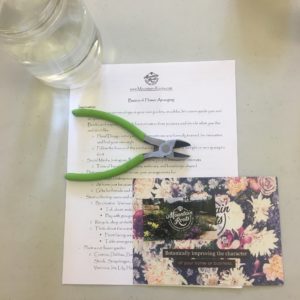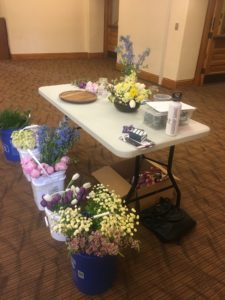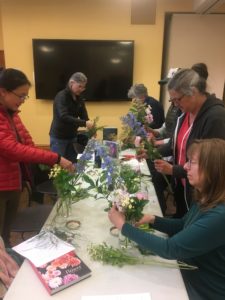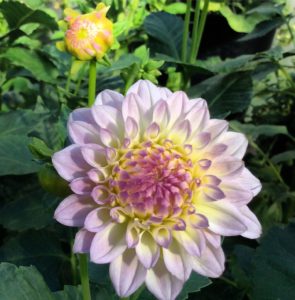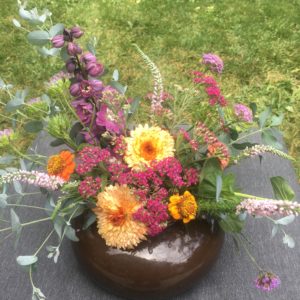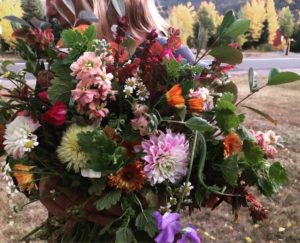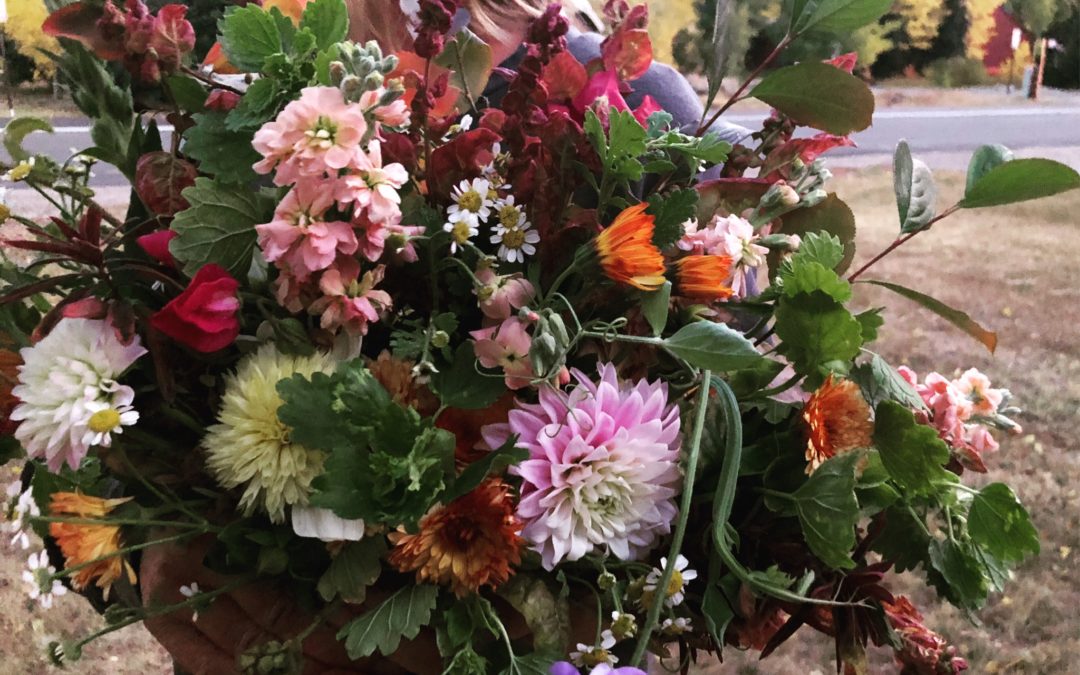In 2019 Mountain Root’s hosted 2 events teaching the Basics of Floral Arranging. The first was in early Spring at the Breckenridge Library. Participants learned the Basics while arranging fresh spring blooms with the snow still falling outside. The second event was another Lady Garden Club event. Friends and their children hand picked cut flowers and blooms right out of the Mountain Roots’ gardens, then arranged a bouquet to take home or gift to someone special. This event was a special way to also show the options for using locally grown seasonal Summit County stems when arranging. Below are tips for Floral Inspiration, Preparation, Arranging, and ongoing care! Fresh flowers are a great way to treat your loved one, yourself, or to spruce up a Holiday or event you are hosting. Enjoy!
Inspiration
- Observe your surroundings, in your own garden, on a hike, let nature guide you and do your best to mimic
- Books and magazines! Look for motivation from pictures and decide what you like and don’t like
- Floral Design in the past has been precise and formally trained, be innovative and find your own style
- Follow the basics of the mechanics, remember, there is no right or wrong way to do it
- Social Media, Instagram, Pinterest, follow people with similar interests
- Tons of live demonstrations, webinars, and knowledge shared
- Determine what you want to use your arrangements for
- Holidays, centerpieces
- At home just because it makes you happy
- Gifts for friends and neighbors, bring joy at times of sorrow or loneliness
- Start collecting vases and containers
- Be creative! Various shapes and sizes
- Tall, short, wide, narrow
- Play with groupings
- Recycle, shop at thrift stores, collect mason jars
- Think about the event and where people will be viewing arrangement
- Front facing arrangement or both sides
- Table arrangement, shorter, corner or entrance piece taller
- Plant a cut flower garden
- Cosmos, Dahlias, Zinnias, Sweet Peas, Marigolds, Sunflowers, Strawflower, Stock, Snapdragon, Pansy, Delphinium, Larkspur, Lupine, Columbine, Veronica, Iris, Lily, Heuchera, Sedum, Lady’s Mantle, Poppy, Tulip, Daffodil
- Be creative! Various shapes and sizes
Flower Color Wheel
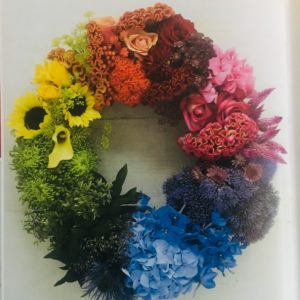
- Primary Colors– Red, Yellow, and Blue, equally spaced on wheel, key anchors that create all different colors when mixed in different proportions
- Harmonious Colors– Colors that are next or near to each other making pleasing combinations.For example, orange and yellow, or pink and purple
- Contrasting Colors– Colors across from each other on wheel that combined create an impactful statement. For example, pink and yellow, or orange and blue
- Less is more- Choose different flower all in the same color scheme. For example all yellow, or all pink
Preparation/Materials
- Shears, Clippers, or Floral Knife- Clean, sanitized and sharp
- Vase or Container- Make sure to clean and sanitize
- Chicken wire, floral frog/pin, floral tape- Floral Foam not recommended
- Floral wire for weak stems, boutonnieres, or corsages
- Garden Gloves for sensitive skin and thorns
- Clean, sanitized bucket to store/treat blooms before arranging
- Flower preservative- FloraLife packets
- Tablespoon of Sugar, Tablespoon of White Vinegar per quart of water
- 50/50 blend of water and citrus soda (7up, Sprite)
- Glass of wine and a good audiobook or music
Flower Choice
- Shop local and choose season blooms- Florists, Dillon Farmer’s Market (Lucky Bee Cut Flowers), Whole Foods, forage from garden
- Take cuttings from live potted plants, for example Jasmine Plant
- Choose blooms for vessel, or vessel based on available blooms
- Allergies?
Flower Types- Stems can often be grouped in various categories
- Frame (Waxflower, Chamomile)– Strongest Stems, helps build the shape of the arrangement, woody stems, and greenery
- Foundation (Stock, Peony) – Flowers with broad faces, provides support or cushion for other plants, fills gaps
- Focal Point (Delphenium, Peony, Tulip)-The star of the arrangement
- Floaters or Fillers (Tulip, Waxflower, Chamomile) – Light, delicate stems, smaller blooms or greenery
Processing of Stems
- Cut 2” off of stem at an angle and place in clean bucket with room temperature water
- Recommended to treat stems for 24-48 hours before event or arranging
- Avoid storing in fridge or cooler unless 100% sanitized for floral storage- Fruits and vegetables can release ethylene, a ripening hormone which can damage flowers
- Place in cool room, out of direct sun
- Choose your vessel and sanitize
- Fill with room temperature water and preservative
- Prepare with chicken wire, floral frog, or tape
- Prepare stems
- Clean off all thorns and leaves, damaged blooms
- Lay out blooms on table together to easily access
Arrange!
- Start with Frame(woody, greener) plants to build shape and support weaker stems
- Use the natural form of stems to determine the shape
- Okay to be uneven or unbalanced
- Arrangement should be 1 to 2 times as big as vessel
- Spin if needed to look at other side, or continue
- Next add Foundation plants (broad faced and large blooms)
- Think of these as support or cushion for Focal and Floater/Filler plants
- Look for blank spots or holes, cover mechanics like chicken wire and tape
- Add Focal Plants (the star of the arrangement)
- Create a strong existence, don’t bury, use the Frame and Foundation plants for support
- Use the natural shape and form to guide you, try different spots as needed
- Think of your arrangement as a living garden, awake and organic
- Add Floaters and Fillers(Light, delicate stems, smaller blooms or greenery)
- Fill in the gaps, soften transitions, hide mechanics
- Delicate Floater stems can sit above the rest, using the support of other plants, use the natural shape and form of stem to determine location
Ongoing Care
- Place in a cool room, out of direct sunlight
- Re-cut stems every 3 days
- Change water every 3 days
- Add more preservative
- Enjoy!
Pro Tips
- Certain plants have specific needs when used as a cut flower
- Daffodils secrete sap that can damage other blooms
- Keep them separate from other blooms in own arrangement
- Process in water for 24 hours alone then add to arrangement
- Oriental Poppies excrete latex causing premature wilting
- Cut stems then put in boiling water or seal stems with a lighter
- Woody stems like Lilacs need to be smashed or cut for extra moisture
- Daffodils secrete sap that can damage other blooms
- Arrange stems in hand as a bouquet, cut stems, then place in vase
- Start small, be creative, and enjoy your blooms!
